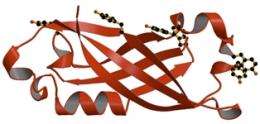Matrix protein key to fighting viruses

Researchers from Durham University's Centre for Bioactive Chemistry are developing methods that show how proteins interact with cell membranes when a virus strikes. Using their approach, the team hopes to find new ways to disrupt and disarm 'enveloped viruses' before they spread in our bodies.
Team members, Dr John Sanderson and Dr Paul Yeo from Durham University have helped produce the first ever, high-resolution, full-length structure of a protein from an enveloped virus called the 'matrix protein'.
Viruses work in many different ways but in this case, respiratory syncytial virus (RSV) virions form by a 'budding' process at the plasma membrane of a cell. The matrix protein appears to drive the final assembly process and the formation of viral filaments. It is also clear that the matrix protein is an important determinant of where the virus buds.
Using x-ray crystallography, the team's been able to see the intimate details of the matrix protein that controls how the RSV virus assembles inside a cell. The technique allows them to see how the virus protein functions and this could help the team to develop biochemical tools to treat respiratory ailments and the common cold.
Dr Yeo said: "We can now see what the protein virus structure looks like and we plan to pull the protein apart to see how and where it might be intercepted. These images provide amazing insights into the micro-chemical world of our cells. We have an opportunity to use bioactive chemistry to develop the medical tools of the future."
The team, funded by Durham University, the Wolfson Institute and One North East, looked at the matrix protein of respiratory syncytial virus (RSV), a virus which is the most dangerous respiratory virus affecting infants and for which there is no vaccine. About one in three people suffering a cold are affected by this particular enveloped virus. They are looking at the way in which the matrix protein pulls the virus together and assembles at the membrane of a cell. This interaction is crucial to the development of cellular disease.
Dr John Sanderson said; "Enveloped viruses can be extremely dangerous. They enter the cell and hijack its machinery. They assemble their own cell parts of proteins and nucleic acids, before pinching off a bit of the membrane lining of a cell, in this case the lung, and going on to infect new cells. Our new hi-resolution structure can help us to see how to disrupt that process."
Durham's researchers have looked closely at the different stages of virus assembly and replication and they are particularly interested at the stage where the virus assembles. It's at this stage that they intend to disrupt the protein.
Dr Paul Yeo said: "If you can intercept the virus at the right time, just before it exits the cell, then your immune system can deal with it. Almost all envelope viruses have to assemble and we want to see how the mechanism works, how the virus latches on to cells and how it buds inside them."
The researchers grew crystals of the protein, crystallised them, and then used x-ray diffraction to determine the position in space of every atom of the protein. The information was then used to create images of the protein's structure. These images enable the team see what different parts of the matrix protein do.
If scientists can understand how the protein binds to cell membranes, then chemists and biological scientists may be able to develop tools to stop the protein mechanism working; this could be a stepping stone to the development of drugs to fight viruses like RSV. The Durham team also hope to work on other viruses such as Hepatitis C and measles.
Dr Sanderson said: "The high-resolution and degree of crystallographic order that we've observed in the structure allows us to throw light on the way in which the membrane binds, and on the mechanism by which this protein performs its varied and critical roles. It's an exciting development that could help in the quest for the biochemical tools of the future."
The 5 stages of virus assembly and replication:
- Entry into the cell
- Replication of genome
- Production of the components of the virus
- Coordinated assembly
- Exit from the cell and release (and multiplication)
Source: Durham University (news : web)
















